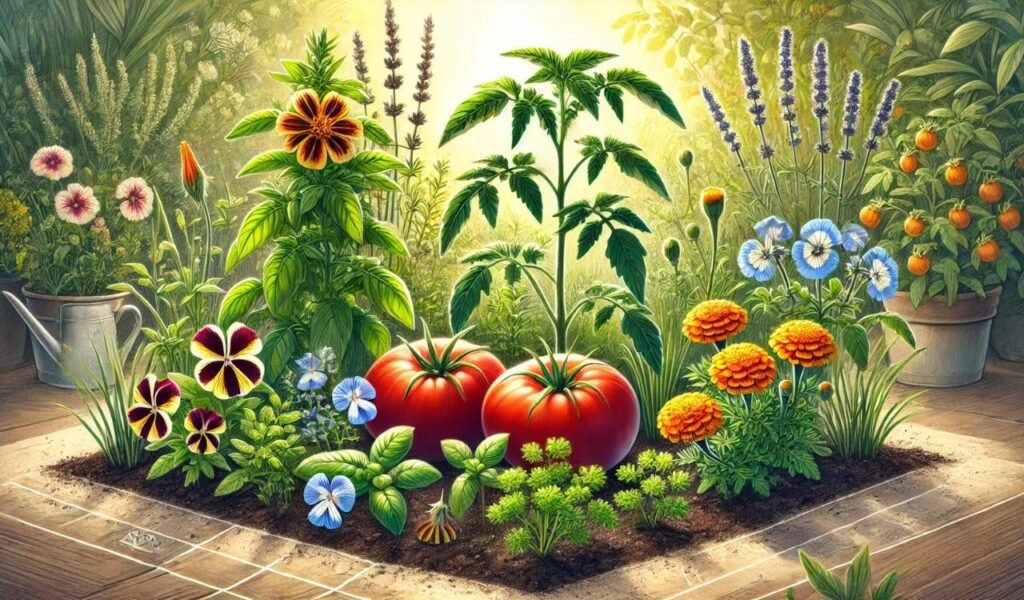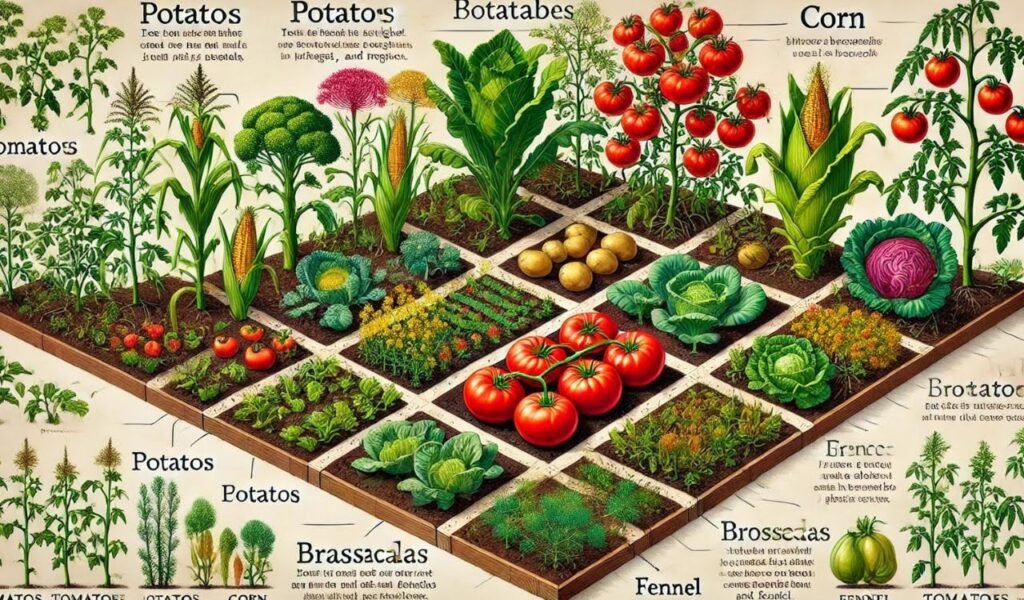What Can I Plant With Tomatoes? A Guide for Beginners
What can I plant with tomatoes? It’s a question every gardener asks when planning the perfect veggie patch. The right companions can supercharge your harvest, keep pests away, and make your garden thrive. But don’t just guess—there’s a science to pairing tomatoes with their ideal partners. Stick around, and we’ll dive into the vegetables, herbs, and flowers that play nicely with tomatoes (and the ones that don’t). Ready to make your tomatoes the talk of the garden? Let’s grow!
Companion Planting Basics
Companion planting is a strategic gardening practice that pairs plants together for mutual benefit, such as enhancing growth, deterring pests, and improving soil health.
The principle of companion planting lies in the idea that some plants work better together. For example, certain plants release chemicals that repel harmful insects, while others attract beneficial pollinators. Tomatoes, being heavy feeders, thrive when paired with plants that improve soil nutrients or protect them from pests. To maximize your tomato harvest, you need to carefully select what to plant next to tomatoes.
Tomatoes benefit from good neighbors, but the wrong companions can lead to stunted growth, disease, or pest infestations. Let’s delve deeper into the best vegetables, flowers, and herbs to plant with tomatoes and the plants you should avoid.
Top Vegetables to Plant With Tomatoes

Carrots: An Underground Ally
Carrots are one of the best vegetables to plant with tomatoes. Their roots grow deep, breaking up compacted soil and improving aeration for tomato roots. Carrots also save space since they grow underground, leaving room above for sprawling tomato vines.
Pro tip: Plant carrots in the same bed as tomatoes early in the season, allowing them to mature before the tomato plants overshadow them.
Peppers: A Shared Love for Warmth
Companion planting tomatoes and peppers is a popular choice. Both plants belong to the Solanaceae family and share similar growing conditions, such as full sun and rich, well-draining soil. Tomatoes and peppers planted together can help conserve garden space and create a microclimate that benefits both crops.
Caution: Keep an eye out for shared pests, such as aphids and hornworms, and consider interplanting pest-repellent herbs like basil.
Onions and Garlic: Natural Pest Deterrents
Onions and garlic are natural companions for tomatoes. Their strong aroma helps deter pests like spider mites and aphids. These alliums are easy to interplant around tomatoes, forming a protective barrier against unwanted insects.
Garden tip: Use garlic and onion bulbs to create homemade pest sprays for an extra layer of protection.
Lettuce: A Shade-Loving Friend
Lettuce is an ideal companion for tomatoes. As tomatoes grow taller and develop dense foliage, they provide the perfect shade for lettuce, which prefers cooler conditions. This pairing allows you to maximize your garden’s output by growing two crops in the same space.
Cucumbers: A Climbing Companion
Can cucumbers and tomatoes be planted together? Absolutely. Cucumbers can grow alongside tomatoes as long as they have adequate support. Trellises or cages allow cucumbers to climb vertically, keeping them off the ground and reducing the risk of fungal diseases. Meanwhile, tomatoes benefit from the additional ground cover cucumbers provide, which helps retain soil moisture.
Best Flowers and Herbs for Tomatoes

Basil: A Flavorful Protector
Basil is a classic companion for tomatoes. Planting basil with tomatoes not only enhances their flavor but also deters pests like aphids, mosquitoes, and whiteflies. The aromatic leaves of basil create a natural barrier against harmful insects while attracting beneficial pollinators.
Gardening anecdote: A small kitchen garden with basil and tomatoes growing side by side is not only functional but also visually appealing.
Marigolds: The Pest Control Champion
When you plant marigolds with tomatoes, you’re setting up a powerful defense system. Marigolds release a substance that deters nematodes, which attack tomato roots. Their bright flowers also attract pollinators and predatory insects, like ladybugs, that help keep pests in check.
Pro tip: Create a border of marigolds around your tomato bed for maximum protection.
Nasturtiums: A Trap Crop for Pests
Nasturtiums are more than just pretty flowers; they act as trap crops by attracting pests like aphids and caterpillars. This keeps harmful insects away from your tomatoes. Their sprawling growth also suppresses weeds and retains soil moisture.
Bonus: Nasturtium leaves and flowers are edible, adding a peppery flavor to salads.
Parsley: Attract Beneficial Insects
Parsley is an excellent herb to plant near tomatoes. It attracts beneficial insects like hoverflies and parasitic wasps that prey on pests. Parsley’s compact size makes it easy to tuck in around tomato plants without competing for space.
Campari Tomato Plants and Borage
If you’re growing Campari tomato plants, consider adding borage. This herb not only attracts pollinators with its star-shaped blue flowers but also improves soil health by adding trace minerals. Additionally, borage deters tomato hornworms, a common pest.
Eco-tip: When borage dies back, use its leaves as mulch to enrich the soil.
Plants to Avoid With Tomatoes

Brassicas: Nutrient Competitors
Avoid planting cabbage, broccoli, and cauliflower near tomatoes. These brassicas are heavy feeders, competing with tomatoes for essential nutrients. Their dense growth can also reduce airflow, increasing the risk of fungal diseases.
Corn: Shared Pests
Corn and tomatoes may seem like a natural pairing, but they attract the same pest: the corn earworm (also known as the tomato fruitworm). Planting these two crops together can lead to significant pest issues.
Garden Tip: Keep corn and tomatoes in separate areas of your garden to minimize pest overlap.
Potatoes: Disease Risks
Tomatoes and potatoes belong to the same family and are susceptible to similar diseases, such as blight. Planting them together increases the likelihood of disease spreading between the two crops. Their roots can also compete for underground resources.
Fennel: A Growth Inhibitor
Fennel releases chemicals that inhibit the growth of nearby plants, including tomatoes. While it’s great for attracting pollinators, fennel is best grown in its own designated space far from tomatoes.
Dill: Timing Matters
Young dill plants can benefit tomatoes by attracting pollinators and predatory insects. However, mature dill releases compounds that can stunt tomato growth. If you’re planting dill, harvest it before it flowers to avoid issues.
Special Focus on Campari Tomato Plants
Campari tomato plants are a favorite among gardeners for their rich flavor and juicy texture. These smaller, vine-ripened tomatoes thrive with the right companions, making companion planting even more critical for their success.When planting Campari tomatoes, consider pairing them with herbs like basil and borage to enhance flavor and deter pests.
Marigolds and nasturtiums are also excellent choices, as they create a protective barrier against nematodes and aphids. Additionally, interplanting with nitrogen-fixing beans can improve soil health and support the Campari tomato’s heavy nutrient demands.
Practical tip: Campari tomato plants benefit from regular pruning and staking. By keeping their growth under control, you can ensure their companions receive adequate light and airflow.
Practical Gardening Tips

1. Plan Your Layout
Before planting, map out your garden to ensure compatible plants are grouped together. This will help maximize space and prevent issues caused by poor companion choices.
2. Rotate Crops
Avoid planting tomatoes in the same spot every year. Crop rotation reduces the risk of soil-borne diseases and nutrient depletion. Pair tomatoes with legumes in a rotation cycle to replenish soil nitrogen.
3. Mulch and Water Consistently
Mulching retains soil moisture and suppresses weeds, creating ideal conditions for tomato plants. Use organic materials like straw or shredded leaves. Water tomatoes consistently at the base to prevent fungal diseases caused by wet foliage.
4. Use Natural Pest Control
Introduce beneficial insects like ladybugs and lacewings to control pests. Consider planting pest-repellent herbs like garlic and marigolds for added protection.
5. Support Your Plants
Tomatoes require sturdy support to thrive. Use cages, trellises, or stakes to keep plants upright, improving airflow and reducing the risk of disease.
Common Mistakes to Avoid
1. Overcrowding
Planting too many crops in a small space limits airflow and increases the risk of fungal diseases. Ensure proper spacing between tomatoes and their companions.
2. Ignoring Soil Health
Tomatoes are heavy feeders and require nutrient-rich soil. Failing to amend the soil with compost or organic fertilizers can result in weak plants and poor yields.
3. Overwatering
While tomatoes need constant watering, overwatering can lead to root rot and nutrient leaching. Aim for deep, infrequent watering to encourage strong root systems.
4. Neglecting Pest Management
Ignoring early signs of pests like hornworms or aphids can lead to significant damage. Regularly inspect your plants and take action at the first sign of trouble.
5. Planting Incompatible Neighbors
Placing tomatoes near incompatible plants like potatoes or fennel can hinder their growth. Research companion planting guidelines to make informed choices.
FAQ
What is companion planting, and why is it important for tomatoes?
Companion planting is the practice of growing different plants together to mutually benefit each other. For tomatoes, it helps enhance growth, deter pests, improve soil health, and maximize garden space. For example, planting basil with tomatoes repels harmful insects while improving the tomatoes’ flavor.
Can I plant tomatoes next to peppers?
Yes, tomatoes and peppers can grow well together because they share similar growing requirements, such as full sun and nutrient-rich soil. However, since they share pests like aphids and hornworms, adding pest-repellent plants like basil or marigolds nearby is recommended.
What herbs should I plant with tomatoes?
Some of the best herbs to plant with tomatoes include basil, parsley, and borage. Basil improves the flavor of tomatoes and repels pests like whiteflies. Parsley attracts beneficial insects, while borage deters tomato hornworms and enriches the soil with minerals.
Why shouldn’t I plant tomatoes near potatoes?
Tomatoes and potatoes are susceptible to similar diseases, such as blight. Planting them together increases the risk of spreading these diseases, and their roots compete for nutrients, hindering growth.
What flowers are good companions for tomatoes?
Marigolds and nasturtiums are excellent flower companions. Marigolds deter nematodes and other pests, while nasturtiums act as a trap crop for aphids and caterpillars. Both attract beneficial pollinators.
Can cucumbers and tomatoes grow together?
Yes, cucumbers and tomatoes can grow together as long as they have proper support like trellises. Cucumbers’ ground cover retains soil moisture, benefiting tomatoes. Ensure good airflow to reduce the risk of fungal diseases.
Final Thoughts
Understanding what to plant with tomatoes can transform your garden into a thriving ecosystem. Companion planting isn’t just about maximizing yields; it’s about creating a balanced environment where plants support one another.From carrots and basil to marigolds and nasturtiums, there are countless options to enhance your tomato crop.
Equally important is knowing which plants to avoid, such as potatoes and corn, to prevent competition and disease.By applying these principles and experimenting with different combinations, you’ll not only grow healthier tomatoes but also cultivate a more productive and harmonious garden.







